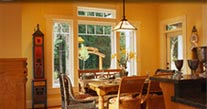Please Note! This is our archived old board, it is “read only.”
To visit our current active discussion board click below.
https://www.replacement-windows.com/windowbb/
| Author: | Robin |
| Subject: | For Windows4U on Gorell Warranty |
| Posted At: | 2004-09-11 02:52:14 |
Below is an portion of Gorells (Website) Waranty. My question is: Do they cover obstruction of vision due to condensation since that is not mentioned? Is film formation condensation or does that relate to the coating or safety glass?
"All glass in the windows/doors is warranted to be free from defects in material and manufacturing for 50 years from the date of purchase, except for commercially acceptable flaws in standard (q3) glass. The insulating glass parts of the windows/doors are warranted to be free from material obstruction of vision caused by film formation and/or dust collection between the interior surface of the glass due to the failure of the seal, under normal use and service, for 50 years from the date of purchase"
| Author: | Oberon |
| In Reply To: | For Windows4U on Gorell Warranty (posted by Robin) |
| Subject: | RE: For Windows4U on Gorell Warranty |
| Posted At: | 2004-09-11 17:15:04 |
I am going to sneak in here Robin, even though the question is for W4U...
I would interpret "film formation" as internal condensation or any sort of internal flaw that might affect visual transmission.
If you have a seal failure, and you have internal condensation, then the (softcoat) Low-E coating has a definite possibility of tarnishing, which certainly affects vision.
Although Low-E coatings have protective layers to keep the silver from tarnishing, there is always the possibility of microscopic pinholes or other (relatively invisible flaws in the protective layers that could let moisture attack the silver.
When they mention "commercially acceptable" flaws, they are probably considering a certain amount of visual distortion that is inevitable in tempered glass or the "rainbow effect" if viewing tempered glass while wearing polarized sunglasses - or occasionally visible in the right lighting at the right angle. These are "acceptable" idiocyncracies of the manufacturing process and are not flaws in the procuct.
But, I am simply suggesting how I interpreted the warranty, I am certain the install and replacement experts have more on this.
| Author: | Window4U |
| In Reply To: | RE: For Windows4U on Gorell Warranty (posted by Oberon) |
| Subject: | RE: For Windows4U on Gorell Warranty |
| Posted At: | 2004-09-11 17:43:50 |
Thanks Oberon.
In the real world Robin, the factories cover anything I call in no questions asked.
Condensation in between the panes is always covered,( by all manufacturers. ) It's the #1 sign of of a slipped seal.
| Author: | Robin |
| In Reply To: | RE: For Windows4U on Gorell Warranty (posted by Window4U) |
| Subject: | RE: For Windows4U and Oberon |
| Posted At: | 2004-09-12 03:03:39 |
Thanks W4U for the reply. I just wanted your veiw since you sell Gorell windows. Oberon also thank you for your input. I have another question for you. Why does the Weight of Krypton make it a better gas than Argon. Ultimately, (and I could be wrong) a vacuum would be the perfect insulator since I would think heat cannot transfer through a perfect vacuum. What does the gas do, pressurize the area to prevent moisture containing air to enter?
Thanks
Robin
| Author: | Window4U (IL) |
| In Reply To: | RE: For Windows4U and Oberon (posted by Robin) |
| Subject: | RE: For Windows4U and Oberon |
| Posted At: | 2004-09-12 03:14:07 |
This is a perfect question for an Oberonic post, so I'm sitting this one out and waiting for a great read.
| Author: | Oberon |
| In Reply To: | RE: For Windows4U and Oberon (posted by Robin) |
| Subject: | RE: For Windows4U and Oberon |
| Posted At: | 2004-09-14 12:30:31 |
Good questions Robin,
And you are absolutely correct, a vacuum would be the perfect insulator for an IG unit. Unfortunately, glass isn't rigid enough to be able to stay in place if there is a vacuum between the two lites.
What you would get is the lites touching in the middle because the exterior air pressure would simply compress the glass to attempt to fill the vacuum with something.
Remember the term "nature abhors a vacuum?"
And that particular explanation is not just theory...there have been research and testing attempting to be able to use a vacuum in an IGU, and there have been a couple of promising ideas that, to date, are simply too expensive of complicated, or unwieldy to actually bring to the market.
Curiously, within the window industry (my opinion) there is more of a debate between using air vs an inert gas in an IG infill more than using argon/krypton/xenon.
The inert gas, whichever one is chosen, is more viscous than regular air, meaning that it retards movement within the panels. Obviously, the denser the medium, the less "air" movement (convestion currents) within the IGU and the greater the efficiency. And, like using fiberglass insulation in a wall cavity, you want to avoid air movement as much as possible. Not a precise analogy, but similar enough idea.
Another of the advantages of using the inert gasses also goes along with your idea of moisture prevention. Air may contain moisture, and moisture inside of an IGU is always a bad idea.
Using an inert gas infill (hopefully) replaces the moisture-laden air between the two lites.
Many of the window companies in North America produce their own IG's and most use various methods of vacuum evacuation tubes to fill the cavity with an inert gas.
Some companies (Andersen, Marvin, maybe 100, 200, or more - I have no idea how many others) buy their IG's from Cardinal. Cardinal uses a patented vacuum/pressure chamber to evacuate the air and to replace it with the inert gas. Or, in some cases to evacuate the "room air" and to replace it with dry, clean, "bottled" air if the requirement is for air and not for an inert gas.
Schuco does the same as well, and they have a really excellent vacuum/pressure chamber system in place for their inert gas fill.
Do other companies use a similar system? You have to ask around.
Now I have to run for a bit, but if anyone is actually reading this, please let me know and I will continue it.
Have a great day all!
| Author: | ARt |
| In Reply To: | RE: For Windows4U and Oberon (posted by Oberon) |
| Subject: | RE: For Windows4U and Oberon |
| Posted At: | 2004-09-14 13:41:49 |
Oberon -
By all means, please go on. Your posts are always quite informative.
| Author: | Robin |
| In Reply To: | RE: For Windows4U and Oberon (posted by Oberon) |
| Subject: | RE: For Windows4U and Oberon |
| Posted At: | 2004-09-16 06:22:44 |
I know that although my posts don't show it I have multiple degrees and although not a physics/thermodynamics type individual I have some idea although your input is helpful. I understand about what you said about the panes/lites touching but that would be highly dependent on the size and thickness of the lites. I know a perfect vacuum is impossible but thought the problem with the vacuum was more in maintaining it than with the panes/lite bowing in to each other. I was thinking that a denser gas (denser being closer to a solid) would actually decrease the insulative properties (I liked Biochem better than organic or general and probably shows). I now can evaluate the movement of the gas inside the pane and maybe better understand what they are trying to do.
Thanks for your input.
Robin





